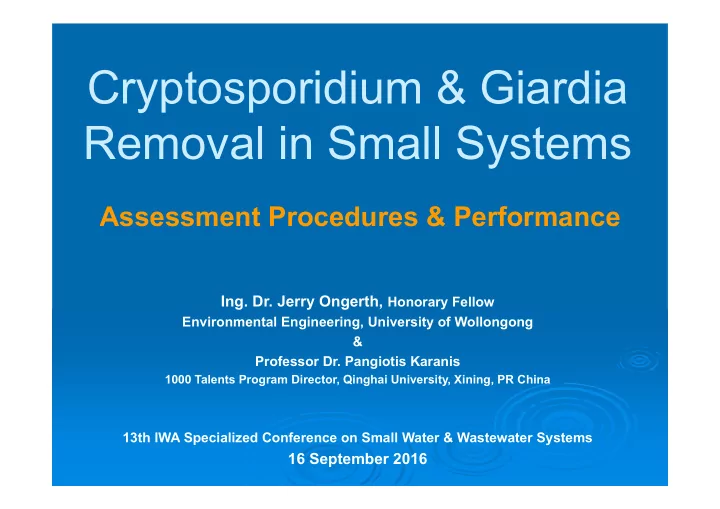

Cryptosporidium & Giardia Removal in Small Systems Assessment Procedures & Performance Ing. Dr. Jerry Ongerth, Honorary Fellow Environmental Engineering, University of Wollongong & Professor Dr. Pangiotis Karanis 1000 Talents Program Director, Qinghai University, Xining, PR China 13th IWA Specialized Conference on Small Water & Wastewater Systems 16 September 2016
OBJECTIVES Crypto & Giardia…universal presence Summary of data on C & G in Europe Measuring treatment performance C & G in alternative treatment systems
Crypto & Giardia Global Summary
Crypto & Giardia Global Summary
FACTORS AFFECTING FILTER PERFORMANCE Water Quality: turb; DOC; part. no. & type Chem. Coag: Chem(Fe;Al); Coag/Filt. aids Flocculation -> (Settling) Filter Design: media size/profile; media comp.; media depth Filter Operation: flow/loading (6->30 m/hr); flowrate contr; term. criteria; backwashing
WATER TREATMENT QUESTIONS Overall Physical Removal? (...%; or logs) Performance of Treatment Components? Effect on Performance of Differences in: design features? (eg. different media size) operating features? (eg. different loading rates) water quality features? (eg. high vs low turb.) Note: All questions require statistical ans.
WATER TREATMENT QUESTIONS...CONT. Statistical Analysis--Resolve the difference between two measurements...eg. “t” tests Ability to Resolve Differences Depends on: Precision (reproducibility) of the assay Number of replicates for each condition Variability in underlying processes At Best...Can Resolve Differences ca. 0.2 to 0.5 logs using n=3 (three replicate meas.)
DESIGN OF PERFORMANCE EVALUATION STUDIES Organisms (seed): 10 8 -10 9 for most runs Organism condition is important Application of Seed Sampling: locations; volumes; time; control Analysis: control (quality); replication (method precision); nonzero results, minimum relative error Full-scale plant performance
TREATMENT PERFORMANCE EVALUATION C 2 =0.1C 1 1 2 C 3 =0.001C 1 Q, C 1 Q b =0.05Q 1 C 2 C 5 =0.1C 4 3 Q 3 , C 3 5 4 C 5 Q b, C 4
TREATMENT PERFORMANCE MEASUREMENTS C 1 =0.23 / L C 1B =0.235 / L 1 2 1B C 3 =0.0005 / L Q, C 1 C 4 =4.9 / L C 2 C 5 =0.37 / L 3 Q 3 , C 3 5 4 C 5 Q b, C 4
Treatment System Types Slow Sand Filtration Pressure Filtration-Automatic Backwash Package Complete Rapid Sand Filtration Complete Rapid Sand Filtration Direct Filtration In-line Filtration Diatomaceous Earth Filtration
Treatment Facilities Included Capacity Seed Organism Location Filtration Type mgd Giardia Crypto. Ref. 100 Mi. House, B.C. Canada Slow sand 1 + 1 Northern Idaho, USA Slow sand 0.07-0.29 + + 2 Darrington, WA, USA Package, direct 0.57 + 3 Grey Eagle CA, USA Pressure, auto 4.0 + 3 Huntington UT, USA Complete & direct 0.9 + 4 Seattle WA, USA Complete & direct, pilot 1 1(gpm) + + 5 Orchard Hills, NSW, Aust. Complete conventional 15 + 6 Wellington NSW, Aust. Complete conventional 5 + + U1* Guerie NSW, Australia Complete conventional, auto 0.2 + + U1* Macarthur, NSW, Aust. Direct, pilot 19.6 + U2* E. Gippsland, VIC, Aust. Complete conventional 4 + U3* Crystal Mtn, WA, USA Diatomaceous earth 0.016 3 1ft 2 UNSW, Sydney NSW, Aust. Diatomaceous earth, pilot 7,8
C & G Removal Performance
Summary Likely C&G concentrations ca. 10-100/L C&G removal Slow sand filtration: < 2-logs Untended rapid sand: ca. 2-logs Optimised rapid sand: 2 to 3-logs DE & Membranes: > 5 to 6-logs Confirm performance by direct sampling
Conclusions C & G…Always present…require control Effective treatment can be provided Design must match local capability Can measure & monitor performance
Questions?
Information to Limit Outbreak Potential Must ASSUME presence of Crypt o & Giardia Need to know: The concentration of all organisms • Live or dead • All species Concentration characteristics--level & variability • Is concentration high or low? • Is concentration constant or variable
Reasons for Monitoring All Species & Live or Dead...Example
Why Measure Concentration? Numbers ≠ Concentration Recovery efficiency varies systematically over annual cycles...different by location
Water Sampling & Analysis Protozoan cysts are: Discrete particles ca from 2 to 20 µM Hardy in the environment...persist for months Concentrations in water are low...ca 1 in 10 L ± Not growing...must find among 10 6 other particles Analysis: Zeros give no useful information! Samples--volume to give nonzero result...>10L Collect particles ≥ organism...e.g. 2µm filter; ppt Concentrate organisms...e.g. IMS (Method 1623) Identification: e.g. IFA Microscopy
Data Analysis Concentration over a typical annual cycle: When High in Winter Site A Site B Site C high & Low in summer low Cumulative Frequency Distribution: 50%ile level for Site A Site B Site C comparison Slope or Std Dev. variability…
Other Possibilities Can Discriminate by Species or Type...but not useful for potential outbreak control Various PCR-based schemes Can Discriminate by apparent viability...but not useful for potential outbreak control Vital staining--e.g. DAPI Cell culture LAMP...can digest particle concentrate w/o separation but still difficult to quantify
Monitoring Approach nalyse monthly samples for a year at a time nalyse volumes to give non zero results nalyse samples for both Crypto & Giardia se mAb’s for detection of all species...most mmercially available mAb’s o not discriminate on apparent viability... all cysts or cysts present show the real risk potential UST measure recovery efficiency and calculate ncentration for each sample nalyse data to show both LEVEL and VARIABILITY risk depends on both
Recommend
More recommend